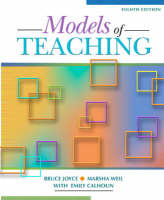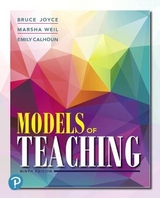
Models of Teaching
Pearson (Verlag)
978-0-205-59345-3 (ISBN)
- Titel erscheint in neuer Auflage
- Artikel merken
Dedication
Preface
Foreword
PART I: FRAME OF REFERENCE
We begin with the idea of giving students the tools that increase their capacity for learning. The primary role of education is to increase student capacity for personal growth, social growth, and academic learning. Models of Teaching is an avenue to liberate student learning capacity and, by doing so, to help teachers take charge of their lives as teachers.
CHAPTER 1: BEGINNING THE INQUIRY
Creating Communities of Expert Learners
On the whole, students are in schools and classes within those schools. Both need to be developed into learning communities and provided with the models of learning that enable them to become expert learners. We study how to build those learning communities.
CHAPTER 2: WHERE MODELS OF TEACHING COME FROM
Multiple Ways of Constructing Knowledge
The history of teacher researchers comes to us in the form of models of teaching that enable us to construct vital environments for our students. Models have come from the ages and from teacher-researchers who have invented new ways of teaching. Some of these are submitted to research and development and how teachers can learn to use them.. Those are the models that are included in this book.
CHAPTER 3: STUDYING THE SLOWLY-GROWING KNOWLEDGE BASE IN EDUCATION
A Basic Guide Through the Rhetorical Thickets
We draw on descriptive studies, experimental studies, and experience to give us a fine beginning to what will eventually become a research-based profession. Here we examine what we have learned about how to design good instruction and effective curriculums. And, we learn how to avoid some destructive practices.
CHAPTER 4: MODELS OF TEACHING AND TEACHING STYLES
Three Sides of Teaching–Styles, Models, and Diversity
We are people and our personalities greatly affect the environments that our students experience. And, as we use various models of teaching our selves -- our natural styles -- color how those models work in the thousands of classrooms in our society. Moreover, those models and our styles affect the achievement of the diverse students in our classes and schools.
PART II: THE INFORMATION-PROCESSING FAMILYOF MODELS
How can we and our students best acquire information, organize it, and explain it? For thousands of years philosophers, educators, psychologists, and artists have developed ways to gather and process information. Here are several live ones.
CHAPTER 5: LEARNING TO THINK INDUCTIVELY
Forming Concepts by Collecting and Organizing Information
Human beings are born to build concepts. The vast intake of information is sifted and organized and the conceptual structures that guide our lives are developed. The inductive model builds on and enhances the inborn capacity of our students.
CHAPTER 6: ATTAINING CONCEPTS
Sharpening Basic Thinking Skills
Students can develop concepts. They also can learn concepts developed by others. Concept attainment teaches students how to learn and use concepts and develop and test hypotheses.
CHAPTER 7: THE PICTURE-WORD INDUCTIVE MODEL
Developing Literacy across the Curriculum
Built on the language experience approach, the picture-word inductive model enables beginning readers to develop sight vocabularies, learn to inquire into the structure of words and sentences, write sentences and paragraphs, and, thus, to be powerful language learners. In Chapter 19 the outstanding results from primary curriculums and curriculums for older struggling readers are displayed.
CHAPTER 8: SCIENTIFIC INQUIRY AND INQUIRY TRAINING
The Art of Making Inferences
From the time of Aristotle, we have had educators who taught science-in-the-making rather than teaching a few facts and hoping for the best. We introduce you to a model of teaching that is science on the hoof, so to speak. This model has had effects, among other things, on improving the capacity of students to learn. We concentrate on the Biological Sciences Study Group, where for 40 years science teachers have shared information and generated new ideas. And, Inquiry training is a "best yet" model for teaching basic inquiry skills.
CHAPTER 9: MEMORIZATION
Getting the Facts Straight
Memorization has had something of a bad name, mostly because of deadly drills. Contemporary research and innovative teachers have created methods that not only improve our efficiency in memorization, but also make the process delightful.
CHAPTER 10: SYNECTICS
The Arts of Enhancing Creative Thought
Creative thought has often been thought of as the province of a special few, and something that the rest of us cannot aspire to. Not so. Synectics brings to all students the development of metaphoric thinking -- the foundation of creative thought. The model continues to improve.
CHAPTER 11: LEARNING FROM PRESENTATIONS
Advance Organizers
Learning from presentations has almost as bad a name as learning by memorization. Ausubel developed a system for creating lectures and other presentations that will increase learner activity and, subsequently, learning.
PART III: THE SOCIAL FAMILY OF MODELS
Working together might just enhance all of us. The social family expands what we can do together and generates the creation of democracy in our society in venues large and small. In addition, the creation of learning communities can enhance the learning of all students dramatically.
CHAPTER 12: PARTNERS IN LEARNING
From Dyads to Group Investigation
Can two students who are paired in learning increase their learning? Can students organized into a democratic learning community apply scientific methods to their learning? You bet they can. Group Investigation can be used to redesign schools, increase personal, social, and academic learning among all students, and -- is very satisfying to teach.
CHAPTER 13: THE STUDY OF VALUES
Role Playing and Public Policy Education
Values provide the center of our behavior, helping us get direction and understand other directions. Policy issues involve the understanding of values and the costs and benefits of selecting some solutions rather than others. In these models, values are central. Think for a moment about the issues that face our society right now -- research on cells, international peace, including our roles in Iraq and the rest of the Middle East, the battle against AIDS, poverty, and who controls the decisions about pregnancy and abortion. Not to mention just getting along together.
PART IV: THE PERSONAL FAMILY OF MODELS
The learner always does the learning. His or her personality is what interacts with the learning environment. How do we give the learner centrality when we are trying to get that same person to grow and respond to tasks we believe will enhance growth?
CHAPTER 14: NONDIRECTIVE TEACHING
The Learner at the Center
How do we think about ourselves as learners? As people? How can we organize schooling so that the personalities and emotions of students are taken into account? Let us inquire into the person who is the center of the education process.
CHAPTER 15: DEVELOPING POSITIVE SELF-CONCEPTS
The Inner Person of Boys and Girls, Men and Women
If you feel great about yourself, you are likely to become a better learner. But you begin where you are. Enhancing self concept is a likely avenue. The wonderful work by the SIMs group in Kansas (see Chapter 3) has demonstrated how much can be accomplished.
PART V: THE BEHAVIORAL SYSTEMS FAMILY OF MODELS
We are what we do. So how do we learn to practice more productive behaviors? Let’s explore some of the possibilities.
CHAPTER 16: LEARNING TO LEARN FROM MASTERY LEARNING
Bit by bit, block by block, we climb our way up a ladder to mastery.
CHAPTER 17: DIRECT INSTRUCTION
Why beat around the bush when you can just deal with things directly? Let’s go for it! However, finesse is required, and that is what this chapter is all about.
CHAPTER 18: LEARNING FROM SIMULATIONS
Training and Self-Training
How much can we learn from quasi-realities? The answer is, a good deal. Simulations enable us to learn from virtual realities where we can experience environments and problems beyond our present environment. Presently, they range all the way to space travel, thanks to NASA and affiliated developers.
PART VI: INDIVIDUAL DIFFERENCES, DIVERSITY, AND CURRICULUM
The rich countryside of humanity makes up the population of our schools. The evidence suggests that diversity enhances the energy of schools and classrooms. However, some forms of teaching make it difficult for individual differences to flourish. We emphasize the curriculums and models of teaching that enable individual differences to thrive.
CHAPTER 19: LEARNING STYLES AND MODELS OF TEACHING
Making Discomfort Productive
By definition, learning requires knowing, thinking, or doing things we couldn’t do before the learning took place. Curriculums and teaching need to be shaped to take us where we haven’t been. The trick is to develop an optimal mismatch in which we are pushed but the distance is manageable.
CHAPTER 20: EQUITY
Gender, Ethnicity, and Socioeconomic Background
The task here is to enable differences to become an advantage. The best curriculums and models of teaching do just that. In other words, if differences are disadvantages, it is because of how we teach.
CHAPTER 21: CREATING AND TESTING CURRICULUMS
The Conditions of Learning
Robert Gagné’s framework for building curriculums is discussed and illustrated. This content is not simple, but it is powerful.
CHAPTER 22: TWO WORDS ON THE FUTURE
The Promise of Distance Learning and Using Models of Teaching to Ensure that No Child is Left Behind.
Afterword
APPENDIX
PEER COACHING GUIDES
Related Literature and References
Index
| Erscheint lt. Verlag | 24.4.2008 |
|---|---|
| Sprache | englisch |
| Maße | 248 x 198 mm |
| Gewicht | 1026 g |
| Themenwelt | Sozialwissenschaften ► Pädagogik |
| ISBN-10 | 0-205-59345-3 / 0205593453 |
| ISBN-13 | 978-0-205-59345-3 / 9780205593453 |
| Zustand | Neuware |
| Informationen gemäß Produktsicherheitsverordnung (GPSR) | |
| Haben Sie eine Frage zum Produkt? |
aus dem Bereich



